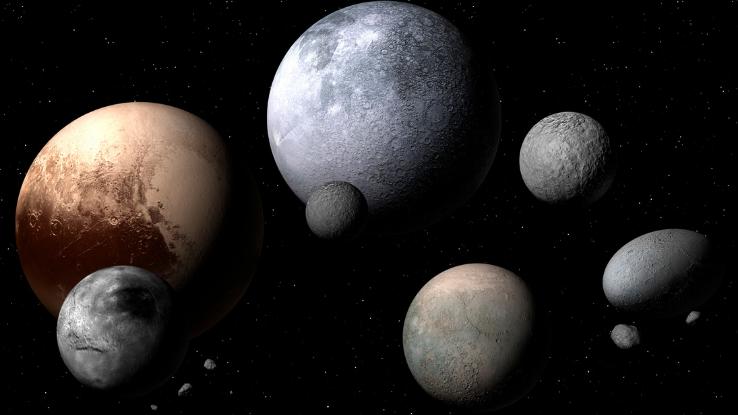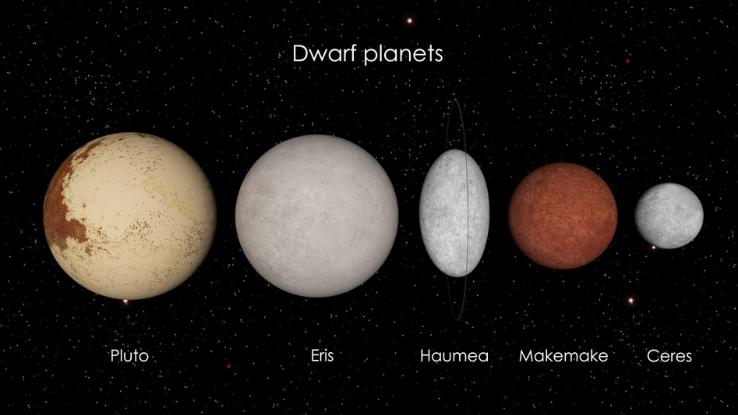What Is a Dwarf Planet?

Our solar system is made up of the sun and the eight planets that revolve around it, but it has a lot more going on. Moons, asteroids and other astronomical objects also orbit the sun — and they’re just as exciting as planets and stars.
You may remember learning that the solar system has nine planets, not eight. Scientists used to consider Pluto a planet, but its planetary status changed in 2006. That’s when NASA announced it was reclassifying some large bodies in space; some planets, planetoids and other astronomical objects became newly designated dwarf planets. This affected more would-be planets than Pluto, but this smaller planetary mass got quite a bit of attention when the renaming process happened.
Although it can sound like Pluto was “downgraded,” taking on the new status of “dwarf planet” doesn’t make Pluto and similar masses any less interesting or important for our solar system. Dwarf planets — much like moons, asteroids and other physical masses in space — are like windows that can tell us more about the universe and its many mysteries. Read on to learn more about what defines a dwarf planet, including its size, features and some notable examples, to see how these planetary bodies have furthered our understanding of outer space.
How Do Scientists Define Dwarf Planet?

The International Astronomical Union (IAU) defines a planet as having three qualities:
- A planet can orbit around the Sun.
- It has sufficient mass to assume hydrostatic equilibrium (a nearly round shape).
- It has “cleared the neighborhood” around its orbit.
In the case of Pluto, it only has the first two qualities. Due to its size, Pluto lacks the heft that NASA requires for space masses to be considered planets, meaning it doesn’t create enough gravity to draw other space objects, like asteroids, toward it while it orbits the sun So what criteria do astronomers use when looking for dwarf planets? As it turns out, it’s a little harder to define them. Scientists don’t have set parameters for what makes something a dwarf planet. It’s ultimately up to astronomers to collectively decide case by case whether a space mass is a dwarf planet or something smaller.
Looking at the dwarf planets known today, there’s a lot to observe when it comes to their size. There aren’t many dwarf planets with a mean radius — the distance from the center of a planet to its edge — below 400km. Ceres, the oldest known dwarf planet, was discovered in 1801.
A dwarf planet’s minimum diameter is generally considered to be 450km. This is also a work in progress, only defined in 2010 by Gonzalo Tancredi. Technology has improved to a point where an object with a diameter that’s smaller than 450km isn’t as noteworthy now as it would have been many years ago. Astronomers are able to see a lot more masses today than in the past, Dwarf planets are small, but not too small.
The largest dwarf planet, Pluto, has a mean radius of 1,188km. That’s 738 miles, a distance that most automobile drivers can take on in half a day. Are dwarf planets big? Absolutely — but not exactly when you compare their typical measurements to Earth’s mean radius of 6,378km. Earth isn’t even the biggest planet in the solar system, but looking at the size differences between planets and dwarf planets can show why scientists make the distinction. Dwarf planets are much smaller than planets, and their size plays a big role in defining them.
What Are Some of the Most Notable Dwarf Planets?

Now that you know what a dwarf planet is, let’s take a look at a few of the most notable dwarf planets in the solar system. These dwarf planets are pictured above and separated by size. Here, we’re breaking them down from their distance from the sun, starting with Ceres, the dwarf planet closest to Earth and the sun.
Ceres, has a mean radius of 476.2km. A single day’s rotation takes nine hours, and this dwarf planet takes more than four Earth years to orbit the sun. A four-year rotation may sound long, but compared to other dwarf planets, Ceres is actually not that far away. Because of its proximity to Earth, scientists have been able to send spacecraft to Ceres.
Next in line, there’s the former planet, Pluto, which was discovered in 1930. It takes 247 Earth years for Pluto to orbit the sun. A single rotation for the dwarf planet takes six days and nine hours. Pluto also has several moons: Charon, Hydra, Kerberos, Nix and Styx.
Haumea is the next closest dwarf planet to the sun. Its mean radius is 780km, which makes this dwarf planet bigger than Ceres but smaller than Pluto. The dwarf planet only takes four hours to fully rotate, but it takes 283 Earth years to fully revolve around the sun. Haumea wasn’t discovered until 2003, which shows us just how much of space is still left to discover.
Makemake is the dwarf planet that’s considered the next closest dwarf planet to the sun. Discovered in 2005, it has a mean radius of 715km. Its rotation period lasts 22 hours and 30 minutes, which is almost like a full Earth day. Makemake’s orbital period is 305 Earth years — a long trip around the sun!
Lastly, let’s look at Eris. While this dwarf planet may be far, far away, it’s the most similar to Pluto in terms of size. When Eris was discovered in 2005, some scientists considered it the 10th planet in our solar system. However, the planet guidelines released in 2006 ultimately classified Eris as a dwarf planet. Eris’s mean radius is 1,163km — almost as big as Pluto. Its orbital period of 557 years really shows us how far away this dwarf planet is from the rest of the bunch.
What Can Dwarf Planets Teach Us?

As we mentioned, dwarf planets may be small, but they can teach astronomers important new things about the universe. One example of this comes from a dwarf planet named Vesta located in the asteroid belt between Mars and Jupiter. After analyzing material from Vesta’s meteorites, scientists learned that the dwarf planet formed 2 million years after the solar system. This finding may seem small, but painting a picture of what the solar system looked like at different times throughout the history of the universe can help researchers understand it better in the long run.
Astronomers were able to look at material from Vesta thanks to NASA’s Dawn spacecraft. In 2007, Dawn also went to Ceres, a closer dwarf planet. From these trips to both dwarf planets, scientists learned new information about that area of the solar system. Many believe that there should be a planet where Vesta and Ceres are, and those masses potentially could have fused to create a larger planetary mass. However, Jupiter’s gravitational pull prevents this, and that’s in part why the solar system has an asteroid belt and no planet between Mars and Jupiter.
Dwarf planets are typically solid masses instead of gas planets like Jupiter and Saturn. This means that sending a rover to explore their surfaces could be easier than sending one to a planet like Neptune. Because of their size, dwarf planets are also more approachable than larger solid planets; they have less gravitational pull and clearer atmospheres. This could make them easier to study in the future as scientists look to learn more about them.
They may be small, and they may not get the same recognition that larger planets do, but dwarf planets have their own unique and scientifically important qualities. Like moons and other masses, dwarf planets are also puzzle pieces that can further our understanding of space — an important contribution in helping us learn about our place in the universe.





